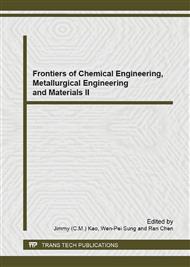[1]
C. Capes, Oil agglomeration process principles and commercial application for fine coal cleaning, Coal preparation, 4 (1991) 1021-1029.
Google Scholar
[2]
K.M. Steel, J. Besida, T.A. O'Donnell, D.G. Wood, Production of Ultra Clean Coal: Part I—Dissolution behaviour of mineral matter in black coal toward hydrochloric and hydrofluoric acids, Fuel Processing Technology, 70 (2001) 171-192.
DOI: 10.1016/s0378-3820(01)00171-0
Google Scholar
[3]
M.G. Plaza, F. Rubiera, J.J. Pis, C. Pevida, Ammoxidation of carbon materials for CO2 capture, Appl. Surf. Sci., 256 (2010) 6843-6849.
DOI: 10.1016/j.apsusc.2010.04.099
Google Scholar
[4]
K.A. Rahman, W.S. Loh, H. Yanagi, A. Chakraborty, B.B. Saha, W.G. Chun, K.C. Ng, Experimental adsorption isotherm of methane onto activated carbon at sub- and supercritical temperatures, J. Chem. Eng. Data, 55 (2010) 4961-4967.
DOI: 10.1021/je1005328
Google Scholar
[5]
V.M. Gun'ko, Y.V. Zaulychnyy, B.I. Ilkiv, V.I. Zarko, Y.M. Nychiporuk, E.M. Pakhlov, Y.G. Ptushinskii, R. Leboda, J. Skubiszewska-Zieba, Textural and electronic characteristics of mechanochemically activated composites with nanosilica and activated carbon, Appl. Surf. Sci., 258 (2011).
DOI: 10.1016/j.apsusc.2011.09.047
Google Scholar
[6]
N. Wang, W. Chu, T. Zhang, X. -S. Zhao, Manganese promoting effects on the Co-Ce-Zr-Ox nano catalysts for methane dry reforming with carbon dioxide to hydrogen and carbon monoxide, Chemical Engineering Journal, 170 (2011) 457-463.
DOI: 10.1016/j.cej.2010.12.042
Google Scholar
[7]
J.F. Moulder, J. Chastain, R.C. King, Handbook of X-ray photoelectron spectroscopy: a reference book of standard spectra for identification and interpretation of XPS data, Physical Electronics Eden Prairie, MN, (1995).
Google Scholar
[8]
S. Kelemen, M. Afeworki, M. Gorbaty, P. Kwiatek, M. Solum, J. Hu, R. Pugmire, XPS and 15N NMR study of nitrogen forms in carbonaceous solids, Energy & fuels, 16 (2002) 1507-1515.
DOI: 10.1021/ef0200828
Google Scholar
[9]
J.H. Zhou, Z.J. Sui, J. Zhu, P. Li, D. Chen, Y.C. Dai, W.K. Yuan, Characterization of surface oxygen complexes on carbon nanofibers by TPD, XPS and FT-IR, Carbon, 45 (2007) 785-796.
DOI: 10.1016/j.carbon.2006.11.019
Google Scholar
[10]
J.R. Brown, M. Kasrai, G.M. Bancroft, K.H. Tan, J. -M. Ghen, Direct identification of organic sulphur species in Rasa coal from sulphur L-edge x-ray absorption near-edge spectra, Fuel, 71 (1992) 649-653.
DOI: 10.1016/0016-2361(92)90167-m
Google Scholar
[11]
M.L. Gorbaty, S.R. Kelemen, Characterization and reactivity of organically bound sulfur and nitrogen fossil fuels, Fuel Processing Technology, 71 (2001) 71-78.
DOI: 10.1016/s0378-3820(01)00137-0
Google Scholar


